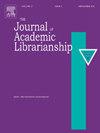Academic librarian schedules and workspaces
IF 2.3
3区 管理学
Q2 INFORMATION SCIENCE & LIBRARY SCIENCE
引用次数: 0
Abstract
Libraries around the world are exploring new models for operating and providing services post-pandemic. Many case studies have been written about individual programs and services, alongside articles about libraries pivoting as a response to COVID-19; however, this study is a large-scale, national study on library work. As academic libraries have been playing with flexible schedules and different types of workspaces, there are major implications for how librarians work and their level of satisfaction with their jobs.
This study of English-speaking Canadian academic librarians is the first national overview of how and where librarians across the country are working, and levels of satisfaction with different working situations and conditions. The following research questions were considered:
- 1.What are librarian work schedules, and are they able to choose their schedules?
- 2.What kinds of workspaces do they have?
- 3.What do they like about their workspaces?
- 4.What do they feel can be improved with their schedules and workspaces?
Results show that the majority of academic librarians work in closed offices, and prefer this set up. Most work on campus between 3 and 5 days a week, and choose which days they work from home.
This study fills a gap in literature on the current working environment in academic libraries, providing comprehensive findings on how librarians feel about their working conditions and schedules. Results are easily adaptable to other library settings and to other academic units.
学术图书管理员时间表和工作空间
世界各地的图书馆都在探索大流行后的运作和提供服务的新模式。许多关于个别项目和服务的案例研究,以及关于图书馆应对COVID-19的文章;然而,这项研究是一项大规模的、全国性的图书馆工作研究。由于学术图书馆一直在实行灵活的时间表和不同类型的工作空间,这对图书馆员的工作方式和他们对工作的满意度产生了重大影响。这项对讲英语的加拿大学术图书馆员的研究是第一次对全国图书馆员如何工作、在哪里工作以及对不同工作环境和条件的满意度进行概述。考虑了以下研究问题:1。图书管理员的工作时间表是怎样的?他们可以选择自己的时间表吗?他们有什么样的工作空间?他们喜欢自己的工作环境是什么?他们觉得他们的日程安排和工作空间有什么可以改进的?结果表明,大多数学术图书馆员在封闭的办公室工作,并且更喜欢这种设置。大多数人每周在学校工作3到5天,并选择哪天在家工作。本研究填补了文献中关于当前学术图书馆工作环境的空白,提供了关于图书馆员对其工作条件和时间表的感受的全面调查结果。结果很容易适应其他图书馆设置和其他学术单位。
本文章由计算机程序翻译,如有差异,请以英文原文为准。
求助全文
约1分钟内获得全文
求助全文
来源期刊

Journal of Academic Librarianship
INFORMATION SCIENCE & LIBRARY SCIENCE-
CiteScore
5.30
自引率
15.40%
发文量
120
审稿时长
29 days
期刊介绍:
The Journal of Academic Librarianship, an international and refereed journal, publishes articles that focus on problems and issues germane to college and university libraries. JAL provides a forum for authors to present research findings and, where applicable, their practical applications and significance; analyze policies, practices, issues, and trends; speculate about the future of academic librarianship; present analytical bibliographic essays and philosophical treatises. JAL also brings to the attention of its readers information about hundreds of new and recently published books in library and information science, management, scholarly communication, and higher education. JAL, in addition, covers management and discipline-based software and information policy developments.
 求助内容:
求助内容: 应助结果提醒方式:
应助结果提醒方式:


